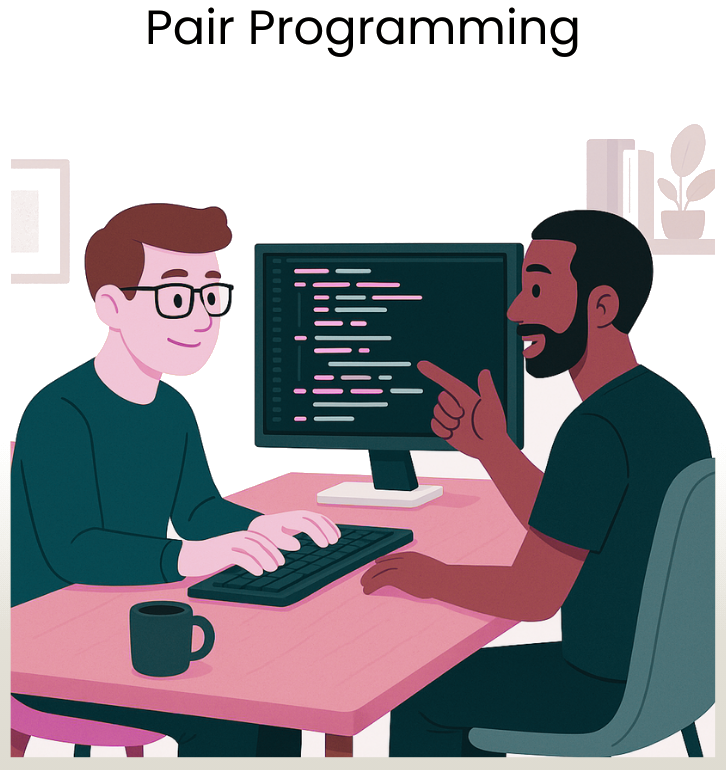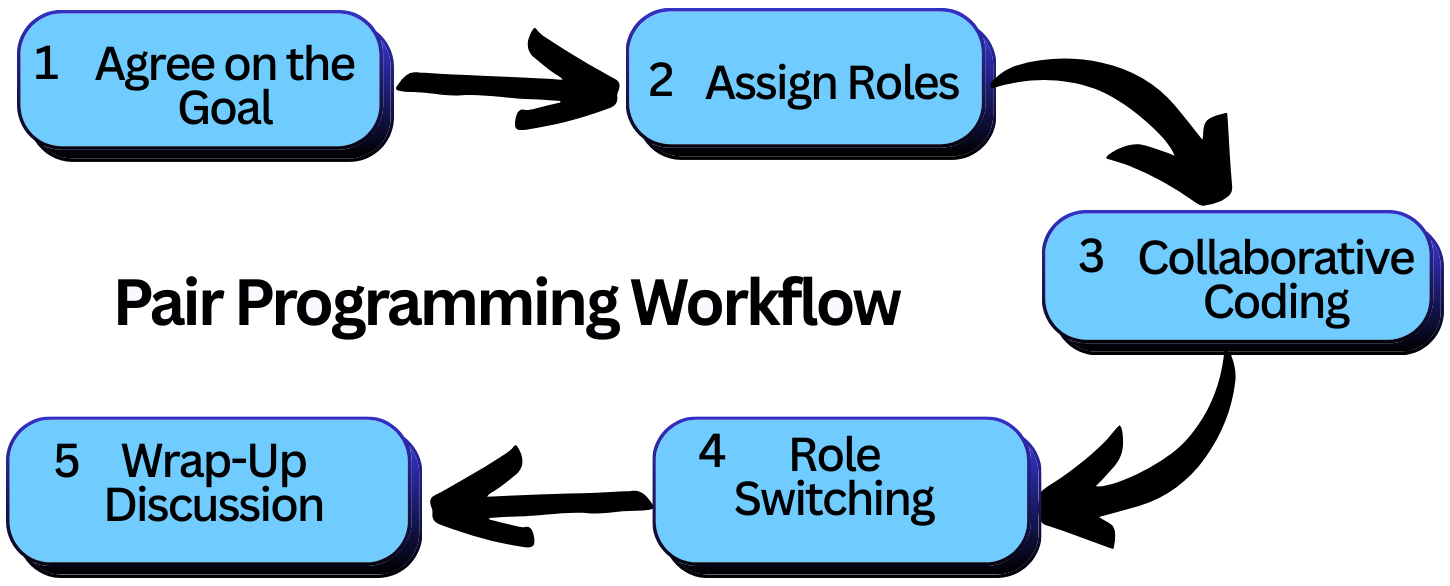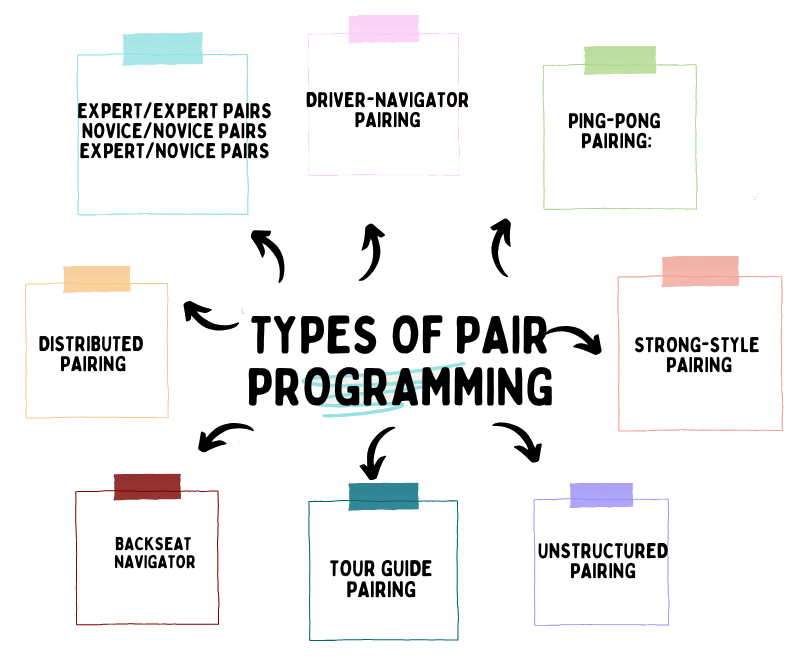What is Pair Programming?
|
|
In software development, efficiency and quality are often in opposite directions. Developers work hard to write code quickly to meet deadlines, but the pace of growth can sometimes come at a cost of scalability, correctness, and maintainability.
But what if we told you that when developers work in pairs, their productivity increases, and code errors decrease? Doesn’t that sound strange? With pair programming, developers can achieve a whole new level of efficiency.
This article delves deeper into pair programming, explaining its origins, workflow, benefits, challenges, and best practices.
| Key Takeaways: |
|---|
|
Origins and Evolution of Pair Programming
The origin and evolution of pair programming can be explained in the following stages:
Early Roots in Collaborative Work
The concept of pair programming stems from traditional collaborative problem-solving approaches used in engineering and research. However, pair programming was first introduced by Kent Beck in the ‘90s through an extreme programming (XP) methodology.
XP methodology supports frequent releases in short development cycles for developers to respond to changing requirements and to improve software quality.
Role in Extreme Programming (XP)
As XP progresses, pair programming became one of its core practices as it reinforced the principles of:
- Continuous Code Review: Identify bugs as code is written.
- Collective Code Ownership: Share knowledge.
- Sustainable Pace: Reduce rework and burnout with shared responsibility.
From Offices to Remote Setups
Traditional pair programming was achieved with both developers sitting side by side in a cubicle. With the rise in remote work post-COVID-19, tools such as Visual Studio Live Share, Tuple, and CodeTogether have enabled distributed teams to pair program across geographical locations.
How Pair Programming Works?
Pair programming is a collaborative software development technique in which two developers work together at one workstation. One developer assumes the role of “Driver,” while the other acts as the Navigator. The driver and navigator review each other’s code for strategic direction, potential issues, and improvements.

The driver and navigator frequently switch roles to maintain engagement and efficiently share knowledge. This collaborative approach improves code quality, catches errors early in development, and enhances problem-solving through shared knowledge and continuous feedback.
Pair programming has two key roles as follows:
- Driver: Driver performs the following functions:
- Writes the actual code.
- Focuses on syntax, immediate problem-solving, and implementing the agreed approach.
- Navigator: is responsible for:
- Review code, spot potential issues, think ahead, and ensure the code aligns with broader project goals.
- Suggests alternative approaches and provides optimizations.
The pairing can be assigned or self-assigned. Both roles switch frequently (every 15-3 minutes or after every task completion), keeping both developers engaged.
Some interesting reads on coding and engineering practices:
- Clean Code: Key Dos and Don’ts for Successful Development
- How to Align Software Engineering with Business Goals
- Understanding the Software Development Process
Pair Programming Workflow
The entire workflow for pair programming goes through the following phases:

- Agree on the Goal: Developers receive the well-defined task. The pair discusses what needs to be done and agrees on one small goal at a time, such as writing code, testing, or just taking notes.
- Assign Roles: Developers decide their respective roles of driver and navigator, and also decide on switching.
- Collaborative Coding: Based on the roles, the driver types the code while the navigator guides and reviews it in real time.
- Role Switching: Roles are swapped to maintain energy and shared ownership. It also enhances communication and coordination.
- Wrap-Up Discussion: The implementation is reviewed, improvements noted, and the code is committed.
Types of Pair Programming Styles
Since its inception, pair programming practitioners have been continuously working to develop models that would work in various scenarios. A few pair programming techniques have evolved, with different teams adapting the style to fit their needs. Some of the types of pair programming are:

- Driver-Navigator Pairing: This is the classic structure we initially discussed. One person, the Driver, writes the code while the other, the Navigator, reviews and guides. The roles are swapped often to keep both developers engaged. Driver-Navigator pairing is the most popular method for tackling complex problems that benefit from continuous code review.
- Ping-Pong Pairing: This is commonly used in test-driven development (TDD). In a ping-pong pairing, one person writes a test, and the other writes code to pass the test. This creates a natural rhythm as developers alternate between writing tests and implementing code.
Ping-pong pair programming ensures comprehensive test coverage and helps maintain good design. This approach needs two keyboards connected to the machine, so that the driver and the navigator can work in quick turns. Read: How to Handle TDD with AI
- Strong-Style Pairing: Strong-style pairing is preferred when knowledge sharing is the main objective. In this, the navigator has the ideas and conveys them to the driver, who acts as a “smart input device”. Strong-style pairing works on the principle that “for an idea to go from your head into the computer, it must go through someone else’s hands”. An experienced developer mentoring a newbie to the codebase or technology can adapt this approach.
- Unstructured Pairing: This is a more flexible approach in which both developers collaborate freely, switching between driving and navigating based on their expertise, personal preference, and energy levels. Experienced pairs not concerned with the structure if formal roles and are comfortable with fluid collaboration work well with this pairing.
- Tour guide Pairing: In tour guide pairing, one developer leads the way, explaining the codebase or imparting domain knowledge. The other developer asks questions and provides feedback. This approach is particularly valuable for onboarding or when diving into legacy systems.
- Backseat Navigator: This is a more relaxed style of programming. Here, the navigator is more passive, offering guidance only when required. For example, they only speak when they notice issues or have specific suggestions, giving the driver more autonomy. The approach works well when the driver is already familiar with the current task and needs an extra pair of eyes to ensure quality.
- Distributed Pairing: A setup where the two programmers work remotely and are connected virtually to work on a project, rather than working face-to-face as practiced traditionally. The developer pair connects via screen-sharing or collaborative coding tools. A more deliberate communication is required in this approach to overcome the lack of physical presence.
In addition to the above pairing methods, development teams can also choose a pair programming styles that align with the developers’ skills. Based on this, we have the following pairs:
- Expert/Expert Pairs: In this type of pair programming, two experts can generally work within any pair programming style. Advanced programmers may prefer the ping-pong style, allowing them to participate even more.
- Novice/Novice Pairs: Two novices, no one experienced enough to take charge, may have difficulty with the driver/navigator style. In addition, the unstructured approach may be difficult for beginner programmers.
- Expert/Novice Pairs: In this setup, an expert programmer works with a less experienced person. This is the most common skill combination. Experts rely on their knowledge to complete the task, while the novice can learn more from the expert.
Tools for Pair Programming
Modern pair programming uses various tools to facilitate collaboration and enhance the development experience. The following table summarizes the tools used in pair programming:
| Tools | Examples |
|---|---|
| Integrated development environment (IDE) extensions |
Visual Studio Code Live Share
|
|
IntelliJ IDEA Code With Me:
|
|
|
Atom Teletype:
|
|
| Web-based development platforms (Cloud-based development environments) |
Replit:
|
|
CodeSandbox:
|
|
|
Gitpod:
|
|
| Project management and version control |
Git co-authoring:
|
|
Slack or Microsoft Teams:
|
|
|
Trello or Jira:
|
Benefits of Pair Programming
The benefits of pair programming are as follows:
- Higher Code Quality: Pair programming performs real-time code reviews, leading to bugs being caught early. The navigator often identifies logical errors or pitfalls before they become costly. Hence, the code quality improves.
- Faster Problem Solving: With two brains working together, they bring more ideas, different perspectives, and quicker resolutions to blockers. Problems are solved faster.
- Improved Knowledge Sharing: Developer pairing spreads domain knowledge and coding practices across the team. Writing new code while working with a subject matter expert can yield more knowledge than working in isolation.
- Skill Development: Pair programming enhances skill development as junior developers learn from their senior counterparts through hands-on collaboration. Senior developers also gain mentorship experience and fresh perspectives from junior developers. Read: Continuous Learning in Software Engineering: A Practical Guide
- Better Team Communication: Frequent interaction between pairs strengthens team relationships and improves collaboration beyond coding.
- Cost-effective: While pair programming requires two developers, the overall time consumed on the project is relatively less than the time taken by a single developer to do the same job.
- Increases job satisfaction levels: Working in a team boosts professionals’ confidence. It also enhances their networking skills, improving the quality of their work. Read: Different Types of Software Engineers: Their Roles and Responsibilities
Challenges of Pair Programming
Pair programming has several challenges, including:
- Higher Immediate Cost: Regarding short-term productivity, two developers working on the same task may seem less efficient.
- Personality Clashes: Differences in communication styles, problem-solving approaches, or skill levels between developers may cause clashes.
- Mental Fatigue: Pair programming requires sustained communication and focus, which can be draining on developers and result in mental fatigue.
- Not Suitable for All Tasks: Pair programming is unsuitable for all tasks. For instance, in the case of very simple or highly individual tasks, solo programming is more appropriate and efficient.
- Remote Work Challenges: When working remotely, developers often face technical issues such as poor internet connectivity, hardware issues, or software glitches. This can disrupt the flow of a remote pair programming session.
- Communication Barriers: Language and cultural differences are the main barriers in pair programming, especially in remote or diverse environments.
- Skill Stagnation: Less experienced developers may become too reliant on their professional partners, leading to skill stagnation.
Best Practices for Successful Pair Programming
Here are the best practices for pair programming to succeed:
- Define Clear Goals: Both developers should agree on the task’s goals before the work begins.
- Set Rules: Before implementing pair programming, clear rules should be set and presented to the team.
- Take It Slow: Do not start by drastically changing developers’ work. Instead, give them a few hours a week to try out the new method, see if it works, and then scale it up based on the results.
- Analyse Pair Composition: Analyze the composition and determine which pair will complement each other and who can learn the most from whom.
- Switch Roles Regularly: Frequent swapping of roles ensures equal engagement and shared responsibility.
- Plan Pair Programming before the Sprint Starts: Before the sprint starts, the best time to determine the team composition, finalize the pairs, and establish the roles is.
- Communicate Openly: Drivers and navigators should communicate openly with drivers, thinking aloud so navigators understand the thought process, and navigators should ask questions.
- Match Skill Levels Strategically: For speed and efficiency, match peers; pair juniors with seniors for mentorship.
- Use the Right Tools: For remote teams, choose tools with shared cursors, low latency, and audio/video integration.
- Gather Team Feedback Regularly: Collect feedback from team members about pair programming and how they feel working in pairs. Regular feedback helps find the best solutions tailored to the company’s current needs and employees’ preferences.
Real-World Use Cases
Pair programming is often used in various industries, including:
Tech Startups
Tech startups face rapidly changing requirements. Pair programming helps teams to adapt quickly, identify issues early, and maintain high-quality code despite tight deadlines.
Enterprise Software
Mission-critical systems where errors are costly use pair programming as constant peer review helps identify early bugs and ensures compliance with standards and regulations.
Education
Conducting coding boot camps and computer science courses that use pair programming, wherein one pair member is a student, enhances student learning and teamwork skills.
Remote Pair Programming in the Modern Era
In remote pair programming, developers work together using various tools and technologies. However, this pairing can introduce complexities like a potential loss in communication, loss of internet connectivity, extra delays in coordination, or increased reliance on tracking tools. Some of the tips for remote paid programming are:
- Have stable internet and good audio quality.
- Use short, frequent breaks to avoid fatigue and burnout.
- Use task boards to track task progress in real-time.
Developers use collaborative coding and IDE tools to share access to code and make references. The developer pair should also schedule a meeting each week on the same day and time to establish the objectives of each week-long sprint.
Here are the tools used for remote pair programming:
- Visual Studio Live Share
- Tuple
- CodeTogether
- GitDuck / Daily.dev
- Zoom / Google Meet with screen share
The Future of Pair Programming
Here are some of the emerging trends for pair programming:
- AI-assisted Development Tools: Tools like GitHub Copilot and ChatGPT for coding will make AU a “virtual pair partner” that can help with boilerplate code, suggest optimizations, and even catch errors. Humans will thus be free to do deeper problem-solving. Read: How to Increase Engineering Output Using AI
- Hybrid Approach of Pair Programming: An approach where developers pair with humans and AI assistants is on the horizon. While machines (AI) help with technical aspects, the human collaboration aspect of empathy, shared understanding, and creativity remains unmatched by machines.
Conclusion
Pair programming is not just coding in pairs; it is a mindset of collaboration, shared ownership, and continuous learning. It requires discipline, communication skills, and the right environment, and teams benefit from it by achieving good code quality, knowledge sharing, and team cohesion.
Adopting pair programming, even part-time, can lead to significant long-term benefits, irrespective of the applications being developed and the company’s status. It should be applied thoughtfully, adapted in the team’s context, and refined continuously.
After all, great software is not just written, it is co-created!
| Achieve More Than 90% Test Automation | |
| Step by Step Walkthroughs and Help | |
| 14 Day Free Trial, Cancel Anytime |












